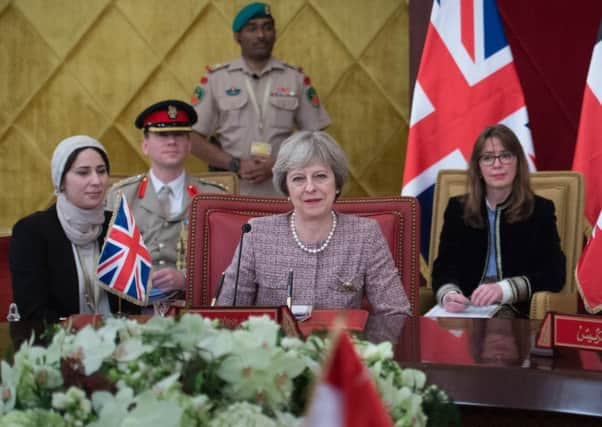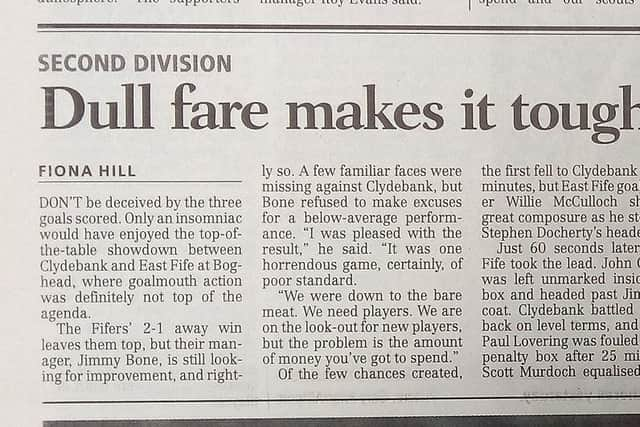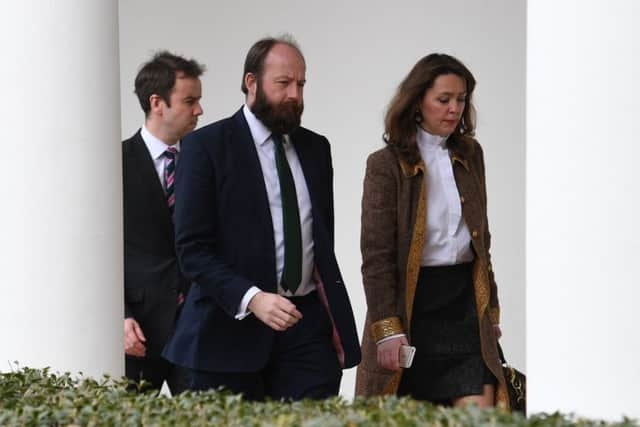Insight: Fiona Hill, from Scotsman reporter to Theresa May's right-hand woman


Twenty-odd years ago, Fiona Hill turned up at the offices of The Scotsman on North Bridge hoping to carve out a career in journalism. Back then, the newspaper industry was thriving and there were plenty of opportunities for ambitious young people to make their mark. Even against this backdrop, however, Hill stood out for her doggedness.
“Fiona turned up on work experience and just kept coming back,” says one former colleague. “She sort of insinuated herself into the place. She hung around the features desk hoping to be given something to do and spent a lot of time socialising in the pub until she became a fixture, though no-one seemed sure what her remit was.”
Advertisement
Hide AdAdvertisement
Hide AdSoon Hill – who took such care over her appearance “she would not have looked out of place on the make-up counter in Jenners” – had collected a handful of bylines from both The Scotsman and the Daily Record, including some for covering football matches.


Donald Walker, who worked on The Scotsman sports desk at the time, recalls someone who wasn’t fazed by the male-dominated environment of lower league press boxes, such as at Clydebank v East Fife. “But although she was keen and able, she wasn’t pulling up trees,” he says. “And when a big story broke at one match she was covering, the arrangement didn’t work.”
“She was quirky and quite funny,” says another former Scotsman journalist. “You wouldn’t have picked her out as unusually talented, or as someone who would go far – she was just kind of omnipresent.”
Today, Hill, 43, is one of the most powerful figures in the country. Joint chief of staff to Theresa May (together with Nick Timothy), she is credited with keeping the Prime Minister away from the public and press during the general election campaign and with encouraging May’s tough and confrontational stance over a second indyref. Often compared to the fictional Malcolm Tucker, she is described as “pugilistic”, “ferocious” and a “control freak”, yet her high standing with the Prime Minister is unquestionable.
Having worked as a special adviser (SpAd) at the Home Office for six years (until a public tiff with Michael Gove led to her resignation), Hill was the driving force behind the Modern Slavery Act 2015. When May addressed regional leaders in Bahrain in December, Hill was one of only two other women in the room; and the Prime Minister is said to have sent Hill and Timothy on a secret diplomatic mission to meet Donald Trump after he suggested Ukip’s Nigel Farage should be the UK’s ambassador to the US.


Though Liberal Democrat coalition minister Norman Baker described moving from the transport department to the Home Office as “like going from somewhere nice and warm to hell”, and another anonymous civil servant said it was not unusual to see Hill with her stockinged feet up on a desk handing out bollockings, she is clearly an effective operator. As Labour MP Frank Field once said: “People know Fiona is not someone you mess about with. She is like a good teacher in control of her class.”
Unlike many behind-the-scenes wielders of power in Westminster (and indeed many journalistic interns), Hill is not from a privileged background. Born in an insalubrious area of Greenock, she later attended St Stephen’s RC Secondary in Port Glasgow, before making her way into newspapers. So what lies behind her meteoric rise? How did she blaze a trail from the bowels of the The Scotsman building through the ranks of the Conservative Party press operation to become May’s right-hand woman?
Advertisement
Hide AdAdvertisement
Hide AdIt is a fascinating story of hard work, ambition, the kind of confidence that cares not a whit for other people’s opinions, and not a little intrigue. Along the way she embarked on a relationship with a former MI6 officer, engaged in several public spats and helped shape May’s wardrobe. But her career trajectory has not been entirely straightforward and her refusal to give an inch has occasionally cost her dear.
Hill’s journalism career didn’t really start to take off until she joined Sky TV – a fertile breeding ground for SpAds – where she started to become interested in politics and ended up on the news desk. While there, she met and married executive producer Tim Cunningham, now head of branded content at Princess Productions, holding their reception in upmarket Wentworth Golf Club in Surrey. For the duration of the marriage, she used his name, going back to her maiden name after her divorce.


But in 2006, Hill joined the Conservative Party press office, where she worked variously as an adviser to Chris Grayling, David Ruffley and Andrew Lansley. She spent a year out working for the British Chamber of Commerce, but soon returned to the fray. At some point, she tried unsuccessfully to win selection for the Tory safe seat of Spelthorne. “I remember her dragging poor Tim off to watch Staines Town on a rainy Saturday afternoon. Such dedication!” a friend from Sky TV, Jon Craig, once blogged of her thwarted efforts.
After the 2010 general election, Hill was appointed to the Home Office where, along with Timothy, she quickly became a trusted adviser. Like Hill, Timothy, who is seven years her junior, was state educated, having joined the Conservative Party while campaigning to save the grammar school he attended in Birmingham. Their influence could be felt in the speech May gave on the injustices faced by “ordinary working class people” when she first became Prime Minister.
It was at the Home Office that Hill began gaining the reputation for being difficult, sweary and pugnacious. Her former Scotsman colleague James Kirkup, now a political commentator for the Telegraph, believes some of these attacks are tinged with sexism. In one newspaper piece, he pointed out how journalists and politicians tended to emphasise Timothy’s intellect and Hill’s fashion sense and instinct as evidence that a particular narrative was developing. She has “gut feeling and reaction to political issues”, while Nick is “doing some of the blue-sky thinking”, Field said.
But in reality they appear to make a formidable and cohesive team, with few doubting the scale of Hill’s contribution. As another friend, the former political editor of the Sun, George Pascoe-Watson, has said: “Fi is not a policy wonk, she’s a media expert by trade, although she is so trusted by Theresa that she does have input in policy. She’s about making sure that Theresa’s agenda is met and that she is well served by the people around her.”


Hill’s strength is said to lie in her versatility. She can move with ease from advising on terrorism to the choice of outfit for an important meeting and she shares May’s interest in clothes and shoes. She also retains the sense of fun evident in her Scotsman days and is able to put May, who is not known for her affability, at ease.
Advertisement
Hide AdAdvertisement
Hide AdIn his blog, Craig said that when Hill and he used to meet for a drink the Osteria dell’ Angolo in Westminster the staff there used to call her “Lady Cunningham”. “I teased her that it was only a matter of time,” he wrote.
The area in which Hill’s input was most marked during her time at the Home Office was on the aforementioned issue of modern slavery – something that had was not much on the radar beforehand. She identified the scale of the problem both globally and in the UK, where 10,000 to 13,000 people are said to be involved in forced work in nail bars, fisheries, hospitality, brothels and other areas.
Under Hill’s influence, May appointed a Modern Slavery Commissioner and introduced the act which made companies accountable for slavery and labour abuses occurring along their whole chain of operations.
However, her abrasive manner means she is also quite capable of making enemies; one is her nemesis, Sir Craig Oliver – son of the former Grampian Police chief Ian Oliver – who replaced Andy Coulson as David Cameron’s director of communications in 2011. The two loathed each other and there were often fiery exchanges over strategy.
It was in part Hill’s loyalty to May and to Hill’s then lover, diplomat and counter-terrorism officer Charles Farr, that lay at the heart of the bust-up in June 2014. It began when the then education secretary Michael Gove briefed Times journalists that it was the failure of the Home Office to tackle the problem of radicalisation that had led to terrorism plots in so-called Trojan Horse schools in Birmingham. In his briefing Gove singled out Farr for criticism.
In revenge, Hill posted a private letter from May to Gove on the Home Office website. In the letter, May accused his department of failing to act when concerns about the Birmingham schools were brought to its attention in 2010. Furious the public fall-out had overshadowed the Queen’s Speech, Cameron demanded an apology from Gove but insisted Hill resign.
From the Home Office, Hill went to the right-wing think tank, the Centre for Social Justice, founded by Iain Duncan Smith, where, as associate director, she continued her work on modern slavery. She produced a report in which she suggested legislation alone was not enough to tackle the problem and pushed for more cooperation between police, borders and immigration officials across Europe.
Advertisement
Hide AdAdvertisement
Hide AdLater, she sparked another controversy by joining lobby group Lexington Communications, which represents a host of blue-chip companies with an interest in government policy, without seeking permission from her former department.
Tougher rules demanding SpAds apply for permission from the Advisory Committee on Business Appointments (ACOBA) had been amended by the Cabinet Office before the election to exclude all but the most senior advisers. But SpAds are still required to seek permission from the permanent secretary before taking any new job within two years of leaving Whitehall. Such permission often comes with conditions that prevent former advisers from lobbying government or using privileged information to help their new employers. Hill’s failure to obey the rule angered campaigners who complained of a lack of transparency.
But her time away from the Conservative Party was, in any case, to be short-lived. When May announced her leadership bid, Hill took time out to help with the campaign, reaping the benefits after May’s victory when Hill was appointed joint chief of staff, at a salary of £140,000.
At No 10, she has consolidated her reputation as a force to be reckoned with. Perhaps her most high-profile outburst came after sacked education secretary Nicky Morgan castigated May for wearing £995 Burberry leather trousers for a photoshoot. Hill texted MP Alistair Burt – who had previously visited May with Morgan to talk about Brexit – telling him: “Do not bring that woman to Number 10 again.” When Morgan found out and responded: “No man brings me to any meeting,” Hill shot back: “Well, he just did; so there!”
More significantly, Hill is thought to have been behind May’s confrontational stance over Nicola Sturgeon’s call for a referendum and her “Now is not the time” message. As for keeping May from the press and public, that’s said to be Hill’s doing too. This tactic is not great for democracy, but subsequent events suggest that from the Tories’ point of view it is a shrewd political move.
May was accused of hiding when she held a rally for 200 supporters in a hut in Banchory in Aberdeenshire where there was no phone signal last month. Shortly afterwards, the Sunday Times ran a story suggesting that – after seeing the itinerary for her visit – she shouted at Hill to “stop cutting [her] time on the doorstep”. “I am a doorstep campaigner and from now on I want to spend proper time knocking on doors and seeing people,” she is supposed to have said.
The risk of allowing May to engage, however, was perfectly demonstrated the following day when the Tory leader, now being tailed by a Sky TV crew, knocked without success on the doors of a row of empty houses, and was snubbed by the only resident who appeared.
Advertisement
Hide AdAdvertisement
Hide AdSince then she has tried to control events to the nth degree, barring reporters from campaign events, refusing to take questions she hasn’t pre-approved and – on one occasion – freaking out when she saw a pen in someone’s hand.
“The thing is though – in their own terms it’s a good strategy,” says one seasoned political commentator. “Theresa May is well ahead, and it’s clear she doesn’t have a great rapport with the press or with ordinary people, so what’s to be gained by putting her in a situation that could backfire.”
Within a few days of announcing a general election, three of May’s team – director of communications Katie Perrior, press secretary Lizzie Louden, and special adviser Hayden Allen – had resigned. The Prime Minister’s official spokesperson Helen Bower, left in December following reports of bad feeling. But, as her boss seeks a bigger mandate for her Brexit plans, and the Tories look to be heading for a landslide, Hill’s loyalty to May seems unwavering, and her influence on the Prime Minister undiminished.